EnduroCross is an incredibly demanding sport, both for the racer and the bike. Physically, one must be in incredible shape with superior strength, stamina and mental focus before he or she can tackle and EnduroCross. Mechanically, a bike must be durable enough to take all the abuse a racer can throw at it, a task that is much easier said that done!While many modern off-road bikes have been designed to handle rigorous obstacles such as those found on an EnduroCross course, it's not practical for every racer out there to own an off-road machine that's specifically built for battle. Sometimes, a rider must transform their motocross bike into something that will work for EnduroCross, but not so severely that it can't be switched back for MX usage. Below is a list of what we feel are the five best things to do to make an MX bike into a fully functional EnduroCross machine:
1. Get a big skid plate. Some of the biggest challenges on an EnduroCross track are the things that can cause the most damage to your bike-namely, the massive boulders and sharp edges that litter the course. Attaching a skid plate to your ride can mean the difference between punching a hole in your engine case and qualifying for the night show. Additionally, a good skid plate will let the bike glide across logs and rocks rather than snag on them, which can slow you down or even put you over the bars. We've had a ton of success with Enduro Engineering's massive skid plate, which protects the side of the engine as well as the bottom of the frame. Sure, the thing gets a bit pummeled on the track, but that's what it's there for!2. Attach some solid handguards. You wouldn't believe the incredible toll that crashing in a rock garden can take on your controls. Unless you have a solid pair of handguards, you're practically inviting something to jump up and break your levers, perches or throttle tube. Do yourself (and your bike) a favor and find some quality handguards if you plan on racing EnduroCross. Not only will this save your little digits from getting wrecked when you tip over, but you can actually use bark buster-style handguards as a grab with which to pick up your machine when you tip over. Again, Enduro Engineering is a popular and smart choice, as coverage and solid mounting are both key to protecting this delicate part of your steed.
3. Dial in your tire pressure. Obviously, 'full' doesn't cut it as a tire pressure setting for EnduroCross. Since trials tires are banned from competition, you need every advantage possible when it comes to finding traction aboard your machine. You can chop up your knobbies to make them hook up better, but that's not always practical for the racer on a budget. One of the best things that you can do is to pay close attention to your tire pressure, which will drastically affect handling and hook-up while out on the track. For EnduroCross, you typically need enough air in both tires to maintain traction without inviting a pinch flat when slamming into obstacles. Because of this, we've found that 11 - 13 pounds of pressure works great in the front tire, while you can typically get away with as low as eight PSI in the rear. Keep a close eye on changes to this setting that result from external air pressure and temperature, and be sure to set the pressure right before you go out so that it is as close to accurate as possible.
4. Set that suspension up. EnduroCross suspension setup is tricky; you want the bike soft enough to not beat you up in the rough stuff, but it needs to be stiff enough to keep the bike working on bigger obstacles. At any rate, a standard MX setup may not be the best thing for you to work with. I'd recommend starting with your motocross settings, but do some testing and consider dropping the rear end of the bike down for a little more stability by going 1-3 turns out on the shock preload from where you typically have it. You don't want the rear end of the bike to kick up, and a few clicks in on the rebound can really be beneficial for taking that edge off and finding that little extra bit of stability. On the fork, you'll want to have good bottoming resistance for hard hits, with rebound that is fast enough to keep the suspension from packing on repeated, sharp hits like those found in some log and river-rock sections. Because of this, a few clicks stiffer on compression and faster on rebound may actually give you the setting that you're looking for. Again, do some experimenting and find something that works for you; you'd be surprised what this can do to your lap times.
5. Prep for success. An EnduroCross race isn't more than a few laps at a time, and due to its short, sprinty nature you must prep the bike perfectly since there are no pit stops or checkpoints at which you can make repairs or do maintenance. You'll want to go through your bike completely to identify any potential problems and fix them before the race starts; also, make sure that all of the bolts and components are tightened properly and not in danger of coming loose or falling off. Check your chain tension and adjust as necessary, and make sure that your bike has fresh oil in it. You'll definitely want a clean filter, and can even go slightly lighter on the oil than normal since you won't be riding in much (if any) dust. Some racers have expressed concern for getting water from an EnduroCross pool onto a filter with water-washable oil, but this is a non-issue: All water-washable air filter oils require agitation in order to clean, and this won't happen on the track unless you drown your bike in a washing machine. Finally, skip the high-capacity fuel tank and don't worry about topping your bike all the way off; more fuel equals more weight and you won't need that much extra gas out on the track.There you have it! If you've completed the above steps, your bike should have the minimal mods necessary to tackle an EnduroCross course. Stay tuned to Dirt Rider as well as [www.endurocross.com](http://www. endurocross.com) for more info about the 2011 series.
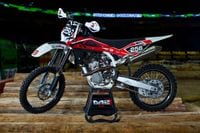
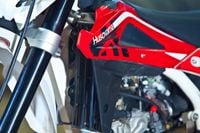
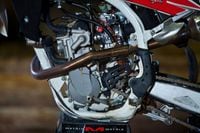

/cloudfront-us-east-1.images.arcpublishing.com/octane/646LH2AYM5CI5OP56WCTRYBPGY.jpg)
/cloudfront-us-east-1.images.arcpublishing.com/octane/FBUJSX2P4JE7XON6OUK4OQCYTY.jpg)
/cloudfront-us-east-1.images.arcpublishing.com/octane/WOYUZXUAMBCZZJ3BQWOEQJGR5M.jpg)
/cloudfront-us-east-1.images.arcpublishing.com/octane/OBHVYZHWBBAZTALZA4GC5RM5WA.jpg)
/cloudfront-us-east-1.images.arcpublishing.com/octane/ZJPPRO5CRNFYPEVMWIFR7RRFQQ.jpg)
/cloudfront-us-east-1.images.arcpublishing.com/octane/MMAOLEHZG5CBXAOICNKNGCEK4I.jpg)
/cloudfront-us-east-1.images.arcpublishing.com/octane/KQUVDTNB6VF53CRDNN47BE3VUA.jpg)
/cloudfront-us-east-1.images.arcpublishing.com/octane/3T32INAZQRGPXOGGA36NQJDSSM.jpg)
/cloudfront-us-east-1.images.arcpublishing.com/octane/EPLS5PBKXBHNXK7S5O7G4ND3YQ.jpg)
/cloudfront-us-east-1.images.arcpublishing.com/octane/MNGOZAGZFZBH5DPFV7NOPF5S3Y.jpg)
/cloudfront-us-east-1.images.arcpublishing.com/octane/VGJWIIFM2VBCXG34KRQ37GCP7U.jpg)
/cloudfront-us-east-1.images.arcpublishing.com/octane/2ZU3HXRPMZESJF7HDLZJV7FHEY.jpg)
/cloudfront-us-east-1.images.arcpublishing.com/octane/VVFWQBZEIZDVJHZIW5ISKWKOZU.jpg)
/cloudfront-us-east-1.images.arcpublishing.com/octane/7T7FZXHIIBDX7AOBD5S3IICUJI.jpg)
/cloudfront-us-east-1.images.arcpublishing.com/octane/T3Y7A52TXBEBJNEPGOQSVPQSPU.jpg)
/cloudfront-us-east-1.images.arcpublishing.com/octane/KY33U3WBTNFIBJFMTEF2SM7BOQ.jpg)
/cloudfront-us-east-1.images.arcpublishing.com/octane/JNPS5MGVXJC7BARVMARYQIQHXE.jpg)
/cloudfront-us-east-1.images.arcpublishing.com/octane/63N2P6SYAZDURJDO5KARQYX2J4.jpg)
/cloudfront-us-east-1.images.arcpublishing.com/octane/C72WX35SXFETTO5OVA2RWT523I.jpg)
/cloudfront-us-east-1.images.arcpublishing.com/octane/F3ER37EV2RGY5CRYFNTWE3JSF4.jpg)
/cloudfront-us-east-1.images.arcpublishing.com/octane/L65QCUR32RH2NKCUHXYHHAPDFI.jpg)
/cloudfront-us-east-1.images.arcpublishing.com/octane/VSK246VVRRDMBNQU7B2NTNY6AE.jpg)
/cloudfront-us-east-1.images.arcpublishing.com/octane/CG64RRFAYRENNAP2AA22T2LSJY.jpg)
/cloudfront-us-east-1.images.arcpublishing.com/octane/IKZSRLBWMRDORMORBXSISL4D6M.jpg)